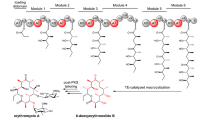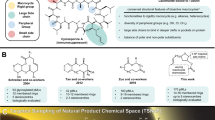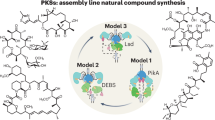Abstract
Structurally complex polyketide natural products, isolated from a variety of marine and terrestrial sources, continue to provide a valuable source of rewarding targets for the synthetic chemist to tackle. In this account, we provide an overview of the total synthesis of several structurally fascinating polyketides with promising anticancer activity completed in our group based on our versatile asymmetric aldol methodology—spirastrellolide A methyl ester, leiodermatolide, rhizopodin and chivosazole F—and highlight the unanticipated challenges and discoveries encountered.
Similar content being viewed by others
Log in or create a free account to read this content
Gain free access to this article, as well as selected content from this journal and more on nature.com
or
References
Newman, D. J. & Cragg, G. M. Marine natural products and related compounds in clinical and advanced preclinical trials. J. Nat. Prod. 67, 1216–1238 (2004).
Norcross, R. D. & Paterson, I. Total synthesis of bioactive marine macrolides. Chem. Rev. 95, 2041–2114 (1995).
Newman, D. J. & Cragg, G. M. Natural products as sources of new drugs from 1981 to 2014. J. Nat. Prod. 79, 629–661 (2016).
Yeung, K.-S. & Paterson, I. Advances in the total synthesis of biologically important marine macrolides. Chem. Rev. 105, 4237–4313 (2005).
Paterson, I. & Anderson, E. The renaissance of natural products as drug candidates. Science 310, 451–453 (2005).
Dalby, S. M. & Paterson, I. Synthesis of polyketide natural products and analogs as promising anticancer agents. Curr. Opin. Drug Discov. Dev. 13, 777–794 (2010).
Paterson, I. & Findlay, A. D. Recent advances in the total synthesis of polyketide natural products as promising anticancer agents. Aust. J. Chem. 62, 624–638 (2009).
Kan, S. B. J., Ng, K. K.-H. & Paterson, I. The impact of the Mukaiyama aldol reaction in total synthesis. Angew. Chem. Int. Ed. 52, 9097–9108 (2013).
Paterson, I. New methods and strategies for the stereocontrolled synthesis of polypropionate-derived natural products. Pure Appl. Chem. 64, 1821–1830 (1992).
Williams, D. E., Roberge, M., Van Soest, R. & Andersen, R. J. Spirastrellolide A, an antimitotic macrolide isolated from the Caribbean marine sponge Spirastrella coccinea. J. Am. Chem. Soc. 125, 5296–5297 (2003).
Paterson, I., Maltas, P. & Anderson, E. A. Total synthesis of (+)-spirastrellolide A methyl ester: challenges and discoveries. Pure Appl. Chem. 85, 1133–1147 (2013).
Williams, D. E. et al. Spirastrellolide A: revised structure, progress toward the relative configuration, and inhibition of protein phosphatase 2A. Org. Lett. 6, 2607–2610 (2004).
Warabi, K., Williams, D. E., Patrick, B. O., Roberge, M. & Andersen, R. J. Spirastrellolide B reveals the absolute configuration of the spirastrellolide macrolide core. J. Am. Chem. Soc. 129, 508–509 (2007).
Williams, D. E. et al. Spirastrellolides C to G: macrolides obtained from the marine sponge Spirastrella coccinea. J. Org. Chem. 72, 9842–9845 (2007).
Paterson, I. & Dalby, S. M. Synthesis and stereochemical determination of the spirastrellolides. Nat. Prod. Rep. 26, 865–873 (2009).
Vintonyak, V. V., Antonchick, A. P., Rauh, D. & Waldmann, H. The therapeutic potential of phosphatase inhibitors. Curr. Opin. Chem. Biol. 13, 272–283 (2009).
O’Neil, G. W. et al. Total synthesis of spirastrellolide F methyl ester—part 1: strategic considerations and revised approach to the southern hemisphere. Angew. Chem. Int. Ed. 48, 9940–9945 (2009).
Benson, S. et al. Total synthesis of spirastrellolide F methyl ester—part 2: macrocyclization and completion of the synthesis. Angew. Chem. Int. Ed. 48, 9946–9950 (2009).
Benson, S. et al. Second-generation total synthesis of spirastrellolide F methyl ester: the alkyne route. Angew. Chem. Int. Ed. 50, 8739–8744 (2011).
Arlt, A., Benson, S., Schulthoff, S., Gabor, B. & Fürstner, A. A total synthesis of spirastrellolide A methyl ester. Chem. Eur. J. 19, 3596–3608 (2013).
Paterson, I. et al. Total synthesis of spirastrellolide A methyl ester—Part 1: synthesis of an advanced C17–C40 bis-spiroacetal Subunit. Angew. Chem. Int. Ed. 47, 3016–3020 (2008).
Paterson, I. et al. Total synthesis of spirastrellolide A methyl ester—part 2: subunit union and completion of the synthesis. Angew. Chem. Int. Ed. 47, 3021–3025 (2008).
Paterson, I., Maltas, P., Dalby, S. M., Lim, J. H. & Anderson, E. A. A second-generation total synthesis of spirastrellolide A methyl ester. Angew. Chem. Int. Ed. 51, 2749–2753 (2012).
Paterson, I. et al. The stereocontrolled total synthesis of spirastrellolide A methyl ester. Expedient construction of the key fragments. Org. Biomol. Chem. 10, 5861–5872 (2012).
Paterson, I. et al. Progress toward a total synthesis of spirastrellolide A. Pure Appl. Chem. 79, 667–676 (2007).
Paterson, I., Anderson, E. A., Dalby, S. M., Lim, J. H. & Maltas, P. The stereocontrolled total synthesis of spirastrellolide A methyl ester. Fragment coupling studies and completion of the synthesis. Org. Biomol. Chem. 10, 5873–5886 (2012).
Chatterjee, A. K., Choi, T.-L., Sanders, D. P. & Grubbs, R. H. A general model for selectivity in olefin cross metathesis. J. Am. Chem. Soc. 125, 11360–11370 (2003).
Nicolaou, K. C., Bulger, P. G. & Sarlah, D. Metathesis reactions in total synthesis. Angew. Chem. Int. Ed. 44, 4490–4527 (2005).
Miyaura, N. & Suzuki, A. Palladium-catalyzed cross-coupling reactions of organoboron compounds. Chem. Rev. 95, 2457–2483 (1995).
Paterson, I. et al. Synthesis of the DEF-bis-spiroacetal of spirastrellolide A exploiting a double asymmetric dihydroxylation/spiroacetalisation strategy. Chem. Commun. 4186–4188 (2006).
Paterson, I., Anderson, E. A., Dalby, S. M. & Loiseleur, O. Toward the synthesis of spirastrellolide A: construction of a tetracyclic C26-C40 subunit containing the DEF-bis-spiroacetal. Org. Lett. 7, 4121–4124 (2005).
Shaojing, H., Jayaraman, S. & Oehlschlager, A. C. Diastereo- and enantioselective synthesis of syn-α-vinylchlorohydrins and cis-vinylepoxides. J. Org. Chem. 61, 7513–7520 (1996).
Paterson, I., Wallace, D. J. & Cowden, C. J. Polyketide synthesis using the boron-mediated, anti-aldol reactions of lactate-derived ketones: total synthesis of (−)-ACRL toxin IIIB. Synthesis 1998, 639–652 (1998).
Kolb, H. C., VanNieuwenhze, M. S. & Sharpless, K. B. Catalytic asymmetric dihydroxylation. Chem. Rev. 94, 2483–2547 (1994).
Paterson, I., Anderson, E. A., Dalby, S. M. & Loiseleur, O. Toward the synthesis of spirastrellolide A: construction of two C1-C25 diastereomers containing the BC-spiroacetal. Org. Lett. 7, 4125–4128 (2005).
Chemler, S. R., Trauner, D. & Danishefsky, S. J. The B-alkyl Suzuki–Miyaura cross-coupling reaction: development, mechanistic study, and applications in natural product synthesis. Angew. Chem. Int. Ed. 40, 4544–4568 (2001).
Takai, K., Kimura, K., Kuroda, T., Hiyama, T. & Nozaki, H. Selective Grignard-type carbonyl addition of alkenyl halides mediated by chromium(II) chloride. Tetrahedron Lett. 24, 5281–5284 (1983).
Jin, H., Uenishi, J., Christ, W. J. & Kishi, Y. Catalytic effect of nickel(II) chloride and palladium(II) acetate on chromium(II)-mediated coupling reaction of iodo olefins with aldehydes. J. Am. Chem. Soc. 108, 5644–5646 (1986).
Inanaga, J., Hirata, K., Saeki, H., Katsuki, T. & Yamaguchi, M. A rapid esterification by means of mixed anhydride and its application to large-ring lactonization. Bull. Chem. Soc. Jpn 52, 1989–1993 (1979).
Shiina, I., Kubota, M., Oshiumi, H. & Hashizume, M. An effective use of benzoic anhydride and its derivatives for the synthesis of carboxylic esters and lactones: a powerful and convenient mixed anhydride method promoted by basic catalysts. J. Org. Chem. 69, 1822–1830 (2004).
Wright, A. E., Reed, J. K., Roberts, J. & Longley, R. E. Antiproliferative activity of the leiodermatolide class of macrolides. U.S. Pat. Appl. Publ. (USA) US2008033035.
Paterson, I. et al. Leiodermatolide, a potent antimitotic macrolide from the marine sponge Leiodermatium sp. Angew. Chem. Int. Ed. 50, 3219–3223 (2011).
Smith, S. G. & Goodman, J. M. Assigning stereochemistry to single diastereoisomers by GIAO NMR calculation: the DP4 probability. J. Am. Chem. Soc. 132, 12946–12959 (2010).
Reiss, A. & Maier, M. E. Toward leiodermatolide: synthesis of the core structure. Org. Lett. 18, 3146–3149 (2016).
Rink, C., Navickas, V. & Maier, M. E. An approach to the core structure of leiodermatolide. Org. Lett. 13, 2334–2337 (2011).
Mailhol, D. et al. Synthesis, molecular editing, and biological assessment of the potent cytotoxin leiodermatolide. J. Am. Chem. Soc. 136, 15719–15729 (2014).
Willwacher, J., Kausch-Busies, N. & Fürstner, A. Divergent total synthesis of the antimitotic agent leiodermatolide. Angew. Chem. Int. Ed. 51, 12041–12046 (2012).
Paterson, I., Paquet, T. & Dalby, S. M. Synthesis of the macrocyclic core of leiodermatolide. Org. Lett. 13, 4398–4401 (2011).
Wulff, W. D. et al. A regioselective entry to vinyl lithiums from unsymmetrical ketones via enol triflates. J. Org. Chem. 51, 277–279 (1986).
Kočovský, P. Carbamates: a method of synthesis and some synthetic applications. Tetrahedron Lett. 27, 5521–5524 (1986).
Paterson, I. & Williams, S. Strategy evolution in the total synthesis of (−)-leiodermatolide. Isr. J. Chem. 57, 192–201 (2017).
Comins, D. L. & Dehghani, A. Pyridine-derived triflating reagents: an improved preparation of vinyl triflates from metallo enolates. Tetrahedron Lett. 33, 6299–6302 (1992).
Gray, M., Andrews, I. P., Hook, D. F., Kitteringham, J. & Voyle, M. Practical methylation of aryl halides by Suzuki–Miyaura coupling. Tetrahedron Lett. 41, 6237–6240 (2000).
Paterson, I., Wallace, D. J. & Velázquez, S. M. Studies in polypropionate synthesis: high π-face selectivity in syn and anti aldol reactions of chiral boron enolates of lactate-derived ketones. Tetrahedron Lett. 35, 9083–9086 (1994).
Paterson, I. & Wallace, D. J. Manipulation of the aldol adducts from lactate-derived ketones. A versatile chiral auxiliary for the asymmetric synthesis of β-hydroxy carbonyl compounds. Tetrahedron Lett. 35, 9087–9090 (1994).
Evans, D. A. & Hoveyda, A. H. Samarium-catalyzed intramolecular Tishchenko reduction of β-hydroxy ketones. A stereoselective approach to the synthesis of differentiated anti 1,3-diol monoesters. J. Am. Chem. Soc. 112, 6447–6449 (1990).
Evans, D. A., Chapman, K. T. & Carreira, E. M. Directed reduction of β-hydroxy ketones employing tetramethylammonium triacetoxyborohydride. J. Am. Chem. Soc. 110, 3560–3578 (1988).
Taniguchi, M., Kobayashi, S., Nakagawa, M., Hino, T. & Kishi, Y. β-Halovinyl ketones: synthesis from acetylenic ketones. Tetrahedron Lett. 27, 4763–4766 (1986).
Paterson, I., Ng, K. K.-H., Williams, S., Millican, D. C. & Dalby, S. M. Total synthesis of the antimitotic marine macrolide (−)-leiodermatolide. Angew. Chem. Int. Ed. 53, 2692–2695 (2014).
Mukaiyama, T., Banno, K. & Narasaka, K. New cross-aldol reactions. Reactions of silyl enol ethers with carbonyl compounds activated by titanium tetrachloride. J. Am. Chem. Soc. 96, 7503–7509 (1974).
Evans, D. A., Dart, M. J., Duffy, J. L., Yang, M. G. & Livingston, A. B. Diastereoselective aldol and allylstannane addition reactions. The merged stereochemical impact of α and β aldehyde substituents. J. Am. Chem. Soc. 117, 6619–6620 (1995).
Jeffery, T. et al. Palladium-catalysed reaction of vinylic halides with allylic alcohols: a highly chemo-, regio- and stereo-controlled synthesis of conjugated dienols. J. Chem. Soc. Chem. Commun. 324–325 (1991).
Fürstner, A. et al. A versatile protocol for Stille–Migita cross coupling reactions. Chem. Commun. 2873–2875 (2008).
Stille, J. K. & Groh, B. L. Stereospecific cross-coupling of vinyl halides with vinyl tin reagents catalyzed by palladium. J. Am. Chem. Soc. 109, 813–817 (1987).
Guzmán, E. A. et al. Leiodermatolide, a novel marine natural product, has potent cytotoxic and antimitotic activity against cancer cells, appears to affect microtubule dynamics, and exhibits antitumor activity. Int. J. Cancer 139, 2116–2126 (2016).
Sasse, F., Steinmetz, H., Höfle, G. & Reichenbach, H. Rhizopodin, a new compound from Myxococcus stipitatus (myxobacteria) causes formation of rhizopodia-like structures in animal cell cultures. Production, isolation, physico-chemical and biological properties. J. Antibiot. (Tokyo) 46, 741–748 (1993).
Gronewold, T. M. A., Sasse, F., Lünsdorf, H. & Reichenbach, H. Effects of rhizopodin and latrunculin B on the morphology and on the actin cytoskeleton of mammalian cells. Cell Tissue Res. 295, 121–129 (1999).
Jansen, R. et al. Isolation and structure revision of the actin-binding macrolide rhizopodin from Myxococcus stipitatus (Myxobacteria). Tetrahedron Lett. 49, 5796–5799 (2008).
Horstmann, N. & Menche, D. Configurational assignment of rhizopodin, an actin-binding macrolide from the myxobacterium Myxococcus stipitatus. Chem. Commun. 5173–5175 (2008).
Pulukuri, K. K. & Chakraborty, T. K. Stereoselective synthesis of the monomeric unit of actin binding macrolide rhizopodin. Org. Lett. 14, 2858–2861 (2012).
Chen, Z., Song, L., Xu, Z. & Ye, T. Synthesis of the C9−C23 (C9′−C23′) fragment of the dimeric natural product rhizopodin. Org. Lett. 12, 2036–2039 (2010).
Nicolaou, K. C. et al. Total synthesis and biological evaluation of monorhizopodin and 16-epi-monorhizopodin. Angew. Chem. Int. Ed. 50, 1139–1144 (2011).
Pulukuri, K. K. & Chakraborty, T. K. Formal synthesis of actin binding macrolide rhizopodin. Org. Lett. 16, 2284–2287 (2014).
Bender, T., Loits, D., White, J. M. & Rizzacasa, M. A. Synthesis of the C1–C18 fragment of rhizopodin: late-state introduction of the oxazole. Org. Lett. 16, 1450–1453 (2014).
Dieckmann, M. et al. Total synthesis of rhizopodin. Angew. Chem. Int. Ed. 51, 5667–5670 (2012).
Kretschmer, M. et al. Modular total synthesis of rhizopodin: a highly potent G-actin dimerizing macrolide. Chem. Eur. J 19, 15993–16018 (2013).
Dalby, S. M., Goodwin-Tindall, J. & Paterson, I. Total synthesis of (−)-rhizopodin. Angew. Chem. Int. Ed. 52, 6517–6521 (2013).
Paterson, I. et al. Total synthesis of (−)-reidispongiolide A, an actin-targeting macrolide isolated from the marine sponge Reidispongia coerulea. Chem. Asian J. 3, 367–387 (2008).
Jadhav, P. K., Bhat, K. S., Perumal, P. T. & Brown, H. C. Chiral synthesis via organoboranes. 6. Asymmetric allylboration via chiral allyldialkylboranes. Synthesis of homoallylic alcohols with exceptionally high enantiomeric excess. J. Org. Chem. 51, 432–439 (1986).
Hinterding, K., Singhanat, S. & Oberer, L. Stereoselective synthesis of polyketide fragments using a novel intramolecular Claisen-like condensation/reduction sequence. Tetrahedron Lett. 42, 8463–8465 (2001).
Hanson, R. M. & Sharpless, K. B. Procedure for the catalytic asymmetric epoxidation of allylic alcohols in the presence of molecular sieves. J. Org. Chem. 51, 1922–1925 (1986).
Gao, Y. et al. Catalytic asymmetric epoxidation and kinetic resolution: modified procedures including in situ derivatization. J. Am. Chem. Soc. 109, 5765–5780 (1987).
De Rosa, M., Soriente, A. & Scettri, A. Enantioselective aldol condensation of O-silyl dienolates to aldehydes mediated by chiral BINOL–titanium complexes. Tetrahedron: Asymmetry 11, 3187–3195 (2000).
Paterson, I., Davies, R. D. M., Heimann, A. C., Marquez, R. & Meyer, A. Stereocontrolled total synthesis of (−)-callipeltoside A. Org. Lett. 5, 4477–4480 (2003).
Narasaka, K. & Pai, F.-C. Stereoselective reduction of β hydroxyketones to 1,3-diols highly selective 1,3-asymmetric induction via boron chelates. Tetrahedron 40, 2233–2238 (1984).
Wipf, P. & Graham, T. H. Synthesis of the C1′-C11′ segment of leucascandrolide A. J. Org. Chem. 66, 3242–3245 (2001).
Burgess, E. M., Penton, H. R. & Taylor, E. A. Thermal reactions of alkyl N-carbomethoxysulfamate esters. J. Org. Chem. 38, 26–31 (1973).
Irschik, H., Jansen, R., Gerth, K., Höfle, G. & Reichenbach, H. Chivosazole A, a new inhibitor of eukaryotic organisms isolated from myxobacteria. J. Antibiot. (Tokyo) 48, 962–966 (1995).
Jansen, R., Irschik, H., Reichenbach, H. & Höfle, G. Chivosazoles A–F: novel antifungal and cytotoxic macrolides from Sorangium cellulosum (Myxobacteria). Liebigs Ann 1997, 1725–1732 (1997).
Diestel, R. et al. Chivosazoles A and F, cytostatic macrolides from myxobacteria, interfere with actin. ChemBioChem 10, 2900–2903 (2009).
Yeung, K.-S. & Paterson, I. Actin-binding marine macrolides: total synthesis and biological importance. Angew. Chem. Int. Ed. 41, 4632–4653 (2002).
Janssen, D., Albert, D., Jansen, R., Müller, R. & Kalesse, M. Chivosazole A—elucidation of the absolute and relative configuration. Angew. Chem. Int. Ed. 46, 4898–4901 (2007).
Brodmann, T., Janssen, D. & Kalesse, M. Total synthesis of chivosazole F. J. Am. Chem. Soc. 132, 13610–13611 (2010).
Williams, S. et al. An expedient total synthesis of chivosazole F: an actin-binding antimitotic macrolide from the myxobacterium Sorangium cellulosum. Angew. Chem. Int. Ed. 56, 645–649 (2017).
Paterson, I. et al. Enantio- and diastereoselective aldol reactions of achiral ethyl and methyl ketones with aldehydes: the use of enol diisopinocampheylborinates. Tetrahedron 46, 4663–4684 (1990).
Paterson, I., Goodman, J. M. & Isaka, M. Aldol reactions in polypropionate synthesis: high π-face selectivity of enol borinates from α-chiral methyl and ethyl ketones under substrate control. Tetrahedron Lett. 30, 7121–7124 (1989).
Phillips, A. J., Uto, Y., Wipf, P., Reno, M. J. & Williams, D. R. Synthesis of functionalized oxazolines and oxazoles with DAST and deoxo-Fluor. Org. Lett. 2, 1165–1168 (2000).
Campbell, A. D., Paterson, D. E., Taylor, R. J. K. & Raynham, T. M. exo-Glycal approaches to C-linked glycosyl amino acid synthesis. Chem. Commun. 1599–1600 (1999).
Kitamura, M., Tokunaga, M., Ohkuma, T. & Noyori, R. Convenient preparation of BINAP-ruthenium(II) complexes catalyzing asymmetric hydrogenation of functionalized ketones. Tetrahedron Lett. 32, 4163–4166 (1991).
Duplantier, A. J. & Masamune, S. Pimaricin. Stereochemistry and synthesis of its aglycon (pimarolide) methyl ester. J. Am. Chem. Soc. 112, 7079–7081 (1990).
Paterson, I., Gibson, L. J. & Kan, S. B. J. Synthesis of the C15−C35 northern hemisphere subunit of the chivosazoles. Org. Lett. 12, 5530–5533 (2010).
Shirokawa, S. I. et al. Remote asymmetric induction with vinylketene silyl N,O-acetal. J. Am. Chem. Soc. 126, 13604–13605 (2004).
Paterson, I., Kan, S. B. J. & Gibson, L. J. Synthesis of the C1−C13 tetraenoate subunit of the chivosazoles. Org. Lett. 12, 3724–3727 (2010).
Littke, A. F., Schwarz, L. & Fu, G. C. Pd/P(t-Bu)3: a mild and general catalyst for Stille reactions of aryl chlorides and aryl bromides. J. Am. Chem. Soc. 124, 6343–6348 (2002).
Ando, K. Highly selective synthesis of Z-unsaturated esters by using new Horner–Emmons reagents, ethyl (diarylphosphono)acetates. J. Org. Chem. 62, 1934–1939 (1997).
Still, W. C. & Gennari, C. Direct synthesis of Z-unsaturated esters. A useful modification of the Horner–Emmons olefination. Tetrahedron Lett. 24, 4405–4408 (1983).
Paterson, I. & Lyothier, I. Total synthesis of (+)-discodermolide: an improved endgame exploiting a Still–Gennari-type olefination with a C1-C8 α-ketophosphonate fragment. Org. Lett. 6, 4933–4936 (2004).
Acknowledgements
The work summarized in this review was carried out by generations of highly able students and postdocs at Cambridge, whose dedication, hard work and contributions are gratefully acknowledged. We thank the Woolf Fisher Trust (scholarship to NYSL) for support, Dr Alison Findlay for helpful discussions and a thorough review of the manuscript and the EPSRC UK National Mass Spectrometry Facility at Swansea University.
Author information
Authors and Affiliations
Corresponding author
Ethics declarations
Competing interests
The authors declare no conflict of interest.
Rights and permissions
About this article
Cite this article
Paterson, I., Lam, N. Challenges and discoveries in the total synthesis of complex polyketide natural products. J Antibiot 71, 215–233 (2018). https://doi.org/10.1038/ja.2017.111
Received:
Revised:
Accepted:
Published:
Issue date:
DOI: https://doi.org/10.1038/ja.2017.111
This article is cited by
-
Ruthenium-catalysed multicomponent synthesis of the 1,3-dienyl-6-oxy polyketide motif
Nature Chemistry (2020)



